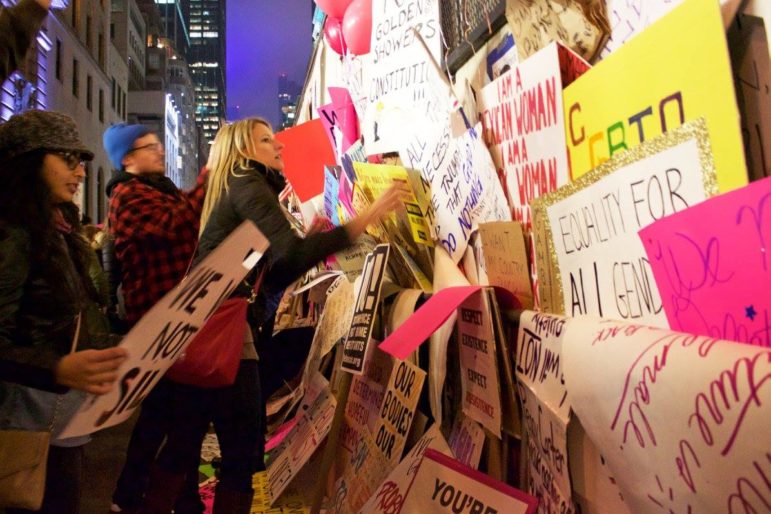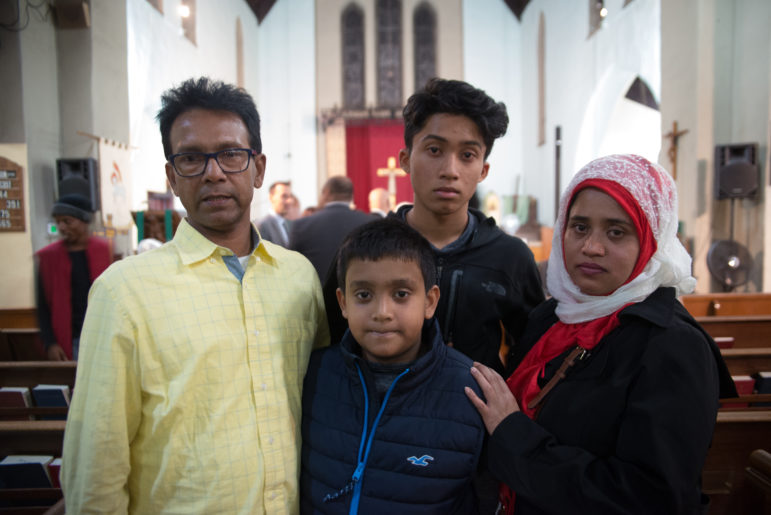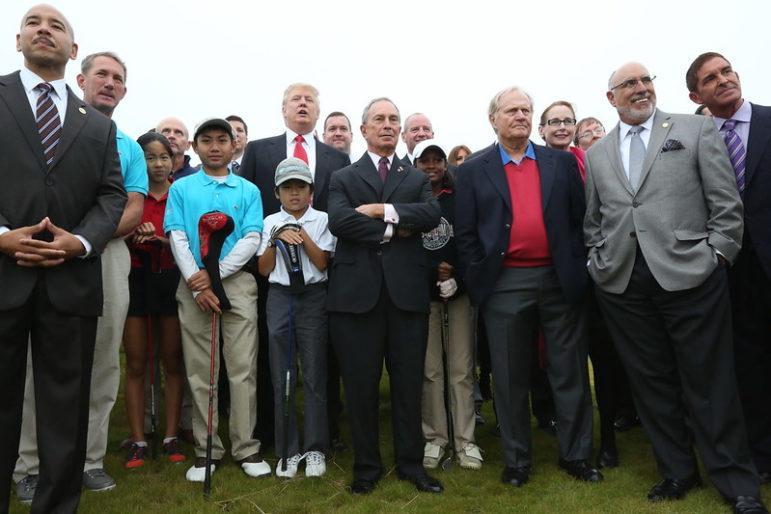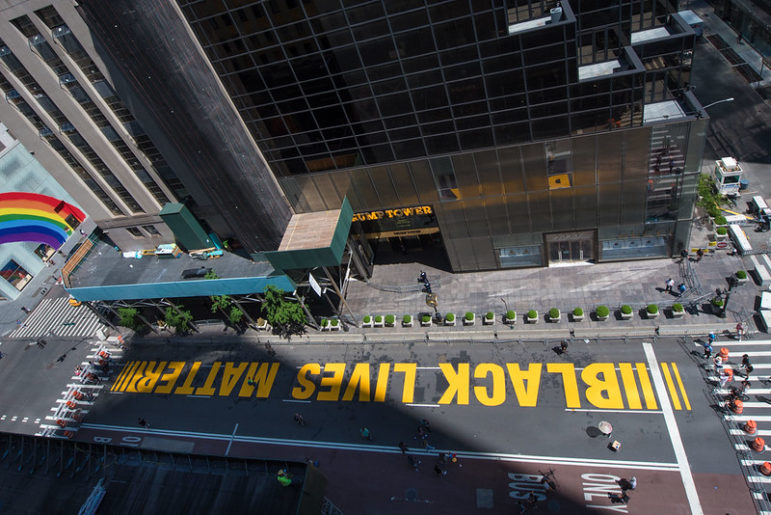A look back on some of the pivotal moments in New York during the last four years, from protests to the immigration ban to Trump’s impact on local elections.

Jeanmarie Evelly
The crowd during the 2016 Women’s March in Manhattan, the day after President Trump’s inauguration.Donald Trump departed the White House for the last time as president Wednesday morning, and President-Elect Joe Biden took the oath of office shortly before noon.
The end of Trump’s term marks a major milestone for the nation as well as New York City, where Trump was born, where he made his name in the real estate industry and where he launched his 2016 campaign riding down the escalators at Trump Tower.
Below, City Limits looks back at some of the pivotal moments in New York during the last four years, and on the impacts of the Trump presidency on the city.
The 2016 Election

Adi Talwar
The Dreiser Loop poll site in the Bronx on Election Day in 2016.Though Trump won the presidency in 2016, he (unsurprisingly) wasn’t so successful in New York, earning just 18 percent of the city’s votes that year. More than 78 percent of city residents cast their ballots for rival candidate Hillary Clinton.
“I think the whole campaign with Trump is a joke,” one Bronx voter told City Limits that Election Day. “I can’t believe people are actually listening to him and how many supporters he has, because of everything that he has said.”
Others, though, were won over by Trump’s message.
“Anyone who tries to increase our economy, I like that,” another voter, a businessman in the Bronx, told one of our reporters at the time. “I think that Trump is better for the economy.”
A New Age of Protests
New Yorkers have taken to the streets countless times over the last four years, protesting Trump’s policies on immigration, policing, the environment and more.
During Trump’s second year in office alone, the city was home to more than 600 protests, including a rally outside Trump Tower on the president’s birthday, protests against his ban of transgender people in the military, his treatment of Puerto Rico after Hurricane Maria and his decision to pull out of the Paris Accord agreement.

Jarrett Murphy
A protest march outside Trump Tower shortly after the 2016 election.
Jeanmarie Evelly
Marchers line a wall with protest signs following the Women’s March in Manhattan in 2016.Threats to NYC’s Role as Sanctuary City

Katie Honan
Queens resident Riaz Talukder came to the United States in the 1980s, when he was still a teenager, and qualified for the late amnesty program for green cards in 1990, he said. He faced the threat of deportation in 2017 after the Trump administration ramped up its immigration enforcement.Trump’s many immigration-related policies and his anti-immigrant rhetoric was felt keenly in New York City, a city home to 3.1 million immigrants.
These policies included his 2017 ban on travel from predominately Muslim countries, his decision to stop issuing permits under the Deferred Action for Childhood Arrivals (DACA) program (a move later overturned by the Supreme Court), and his efforts to ramp up Immigration and Customs Enforcement — all of which sowed fears of ICE raids and deportation among the city’s immigrant communities.
Read More:
- Queens Community Rallies Around Father of Two Told to Buy Plane Ticket for Deportation
- Trump Administration’s Obsession on Immigration: More Than 400 Policy Changes So Far
- ICE Reactivates in New York: Advocates Demand Investigation
The Trump Effect

Adi Talwar
Inside the polling Station located in PS41 on Olinville Avenue in the Bronx in 2018.While Trump wasn’t on the ballot during the 2018 elections, his presence was felt at the polls: anti-Trump sentiment helped drive a “blue wave” of victories for Democratic candidates in New York that year — including Alexandria Ocasio-Cortez’s win in the Bronx, Max Rose’s upset on Staten Island and Democrats’ seizing control of the State Senate.
Read More:
- Democrats Seize Full Control of NYS, Thanks in Large Part to Donald Trump
- Max Rose Rides to Upset Win on the Island
- ‘Blue Wave’ Washes Into the Bronx as Ocasio-Cortez, Biaggi Rally Voters
Rudy’s Re-emergence

Trump’s presidency brought another famous New Yorker back into the national spotlight: former Mayor Rudy Giuliani, who joined Trump’s legal team in 2018 amidst the federal investigation into Russian election interference.
Since then, the one-time “America’s mayor” has continued his public — and oftentimes bizarre — defense of President Trump, most recently in his erronous and unsuccessful attempt to overturn the results of the 2020 election.
Read more:
Bloomberg and de Blasio’s Presidential Runs

Michael Appleton/Mayoral Photography Office
Mayor de Blasio performs with comedian and President Trump impersonator Anthony Atamanuik during the 96th Inner Circle charity show in 2018.Speaking of New York City mayors: two of them threw their hats in the ring against Trump in the 2020 presidential election.
Former Mayor Michael Bloomberg officially launched his campaign in November 2019, before dropping out of the race in March of 2020 and endorsing Biden. Mayor Bill de Blasio launched his own campaign for the White house in May of 2019 before suspending his run in September of last year.
Read more:
Cutting Ties

Spencer T Tucker/Mayoral Photography Office
Bronx Borough President Ruben Diaz, Jr., Mayor Bloomberg, golf great Jack Nicklaus and other pols join Donald Trump at the 2013 announcement that construction was completed on the Trump Golf Links at Ferry Point.
Michael Appleton/Mayoral Photography Office
The city painted a Black Lives Matter mural on Fifth Avenue in July.Since Trump took office, local officials haven’t exactly rolled out the welcome mat for the former New Yorker. State Attorney General Letitia James has taken legal action against both the Trump Organization and the Trump administration. Last July, de Blasio painted a massive Black Lives Matter mural outside Trump Tower. Most recently, the de Blasio administration announced it is taking steps to cancel the city’s contracts with the Trump Organization, which currently operates Central Park Carousel, the Wollman and Lasker ice skating rinks and the Ferry Point Golf Course in the Bronx.
Read more:









One thought on “PHOTOS: NYC’s Trump Years”
I have been exploring for a little bit for any high-quality articles or weblog posts in this sort of space .
Exploring in Yahoo I ultimately stumbled upon this web site.
Studying this information So i am glad to exhibit
that I’ve an incredibly just right uncanny feeling I found out exactly what I
needed. I so much unquestionably will make certain to do
not overlook this site and provides it a look
on a constant basis.